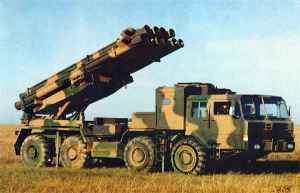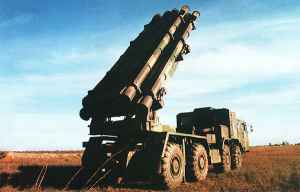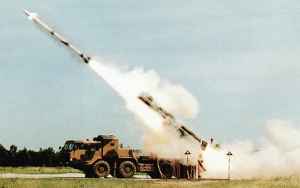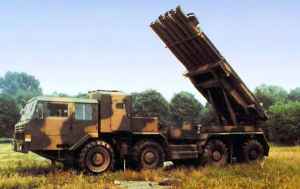| Designation: | A-100 |
 |
|---|---|---|
| Manufacturer: | China Precision Machinery Import and Export Corporation (CPMIEC) | |
| Product type: | Armoured Vehicles | |
| Name: | Self-propelled rocket launcher |
The A-100 is the 300mm, 10-tube multiple launch rocket system developed by Beijing-based China Academy of Launch Vehicle Technology (CALT, also known as 1st Space Academy) for the PLA ground forces. In many aspects, the system is very similar to the Russian Smerch 9K58 300mm rocket system. Its rocket is fitted with a primitive guidance system for greater accuracy. In 2002 the rocket system was spotted in service with the PLA 1st Artillery Division in Guangzhou Military Region, possibly for trial and evaluations.
China reportedly received a small number of the Russian Smerch 9K58 300mm, 12-tube multiple launch rocket system and its ammunitions in 1997. The Smerch 9K58 system is capable of firing a ‘smart’ submunition that has a dual-colour infrared sensors for terminal guidance, which enables the rocket to achieve accuracies previously difficult to achieve with unguided rockets of that range. The submunition is fitted with kinetic energy fragment warheads which are said to be able to penetrate 70mm of armour at an angle of 30° to the normal.
China National Precision Machinery Import and Export Corporation (CPMIEC), a trading company that market Chinese missile and defence technologies to foreign customers, revealed the A-100 300mm, 10-tube multiple launch rocket system in 2000. The system was developed by CALT, which is famous for its ChangZheng (Long March) family of space launch vehicles and DongFeng family of ballistic missiles. The A-100 system is CALT’s first attempt to break into the tactical weapon market. The A-100 development possibly began in the late 1990s and the weapon was spotted in service with the PLA 1st Artillery Division in Guanbgzhou MR in 2002.
CPMIEC claimed to have developed a range of rockets with ranges between 40km and 100km, but the actual effective range of the weapon may be around 85km. The A-100 rocket is fitted with a primitive guidance for greater accuracy. The PLA’s acquisition of the A-100 system demonstrated its interest in upgrading its artillery with “deep strike” tactics and capabilities. Combined with advanced intelligence, surveillance, target acquisition, and reconnaissance (ISTAR) capabilities and “smart munitions”, the A-100 would enable the ground forces to defeat large armoured formations at “beyond-visual-range”.
The launch vehicle is based on a TAS5380 8X8 wheeled truck chassis developed by Tai'an Special Vehicle Manufactory. The vehicle weights 21t and has a maximum load of 22t. The vehicle has a maximum road speed of 60km/h and a maximum range of 650km. The vehicles has a gradient of 57% and a fording depth of 1.1m. The vehicle is equipped with four hydraulically operated stabilisers which are lowered in preparation for the rocket launch. 10 launcher tubes mounted on the chassis are arranged as two blocks of four (top) and six (bottom) tubes.
The vehicle is fitted with a GPS to provide real-time positioning data. A computerised aiming system collects meteorological and other parameters from various sensors and automatically calculate the trajectory for the rockets. The system could complete the process of target setting and pre-launch examination for all 10 rockets within 90 seconds and launch all 10 rockets within 60 seconds. The system is capable of both single and salvo firing.
The A-100 fires 300mm rocket powered by a solid propellant rocket motor, with a firing range of 40~100km. The A-100 rocket is 7.3m in length and weights 840kg. The rocket carries a 235kg warhead, and is stabilised by spin, thrust, and stabilising fins. It is fitted with a warhead containing 500 HE-FRAG (High Explosive Fragmentation) anti-armour/personnel submunitions. The submunition can penetrate 50mm of armour, and has a blast radius of 7m. The submunitions have a spreading radius of 100 +/- 40 metres.
The rocket consists of the warhead and fuse, a thrust stabilising system, a rocket motor and the tail section. The rocket motor is a single chamber, solid rocket motor with an advanced hydroxy-terminated polybutadine (HTPB) composition rocket propellant. The stabilising fins are folded inside the launch tube and open once the rocket leaves the tube.
The rocket is equipped with an onboard computer to help correct the horizontal and vertical deviations. During the first three seconds of the rocket’s flight, the onboard computer detects the horizontal difference between the programmed trajectory and actual status of the rocket, and controls the rocket’s stabilising thrust system to correct the rocket’s flying direction. The onboard computer corrects the vertical deviation by adjusting the warhead detonation time so that the submunitions are spread with a high accuracy.
The ground equipment comprises a rocket launch vehicle, a transport and loading vehicle, and a firing command vehicle. A rocket system battery is equipped with one firing command vehicle, 6~9 rocket launch vehicles, and 6~9 transport and loading vehicles.
The command vehicle is mounted on a 6X6 truck chassis. It is equipped with a radio communications and data transmission system; a firing and control computer and simulation trajectory system; and a global positioning system. It collects the meteorological information, calculate the trajectory and transmits the data to the firing units.
|
||||||||||||
 |
 |
 |
 |
 |
